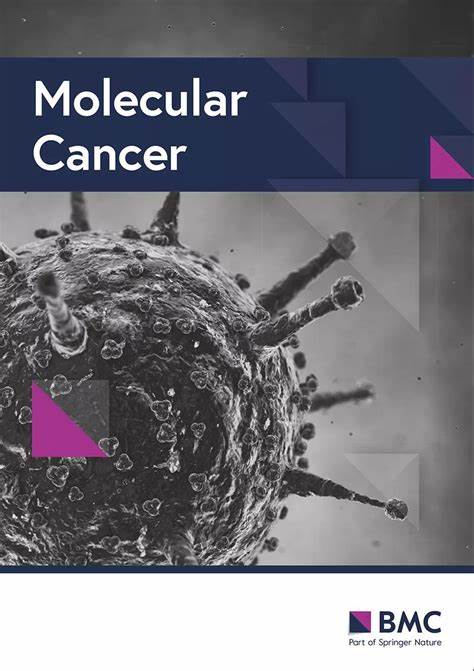通过间皮素特异性纳米抗体共轭推进胰腺癌治疗
IF 27.7
1区 医学
Q1 BIOCHEMISTRY & MOLECULAR BIOLOGY
引用次数: 0
摘要
胰腺腺癌(PAAD)由于预后不良和有效治疗方案有限,治疗极具挑战性。脂质体纳米技术已经成为一种很有前途的肿瘤药物传递平台,但现有的脂质体疗法面临着诸如全身毒性、肿瘤选择性不足和低靶点特异性等局限性。间皮素(Mesothelin, MSLN)是一种在PAAD中过表达的抗原,作为精准治疗的潜在靶点引起了人们的关注。在这里,我们开发了一种具有高结合亲和力(KD = 2.2 nM)的抗msln纳米体(D3 Nb),可以选择性地与msln阳性癌细胞结合。结构分析显示,D3 Nb的互补决定区(CDR)内的疏水键和氢键促进了与MSLN的强结合,导致AKT/NF-κB信号明显抑制,纤维连接蛋白1 (FN1)和twist1下调,这是PAAD致癌性的关键驱动因素。体内研究证实,D3 Nb单独抑制肿瘤进展。此外,选择性给药msln阳性肿瘤联合吉西他滨负载脂质体(D3-LNP-GEM)可显著改善细胞毒性并促进肿瘤消退。这些发现突出了D3-LNP-GEM平台作为表达msln的恶性肿瘤的新型靶向治疗的潜力,在临床前模型中显示出有希望的疗效,并为继续进行临床评估铺平了道路。本文章由计算机程序翻译,如有差异,请以英文原文为准。
Advancing pancreatic cancer therapy by mesothelin-specific nanobody conjugation
Pancreatic adenocarcinoma (PAAD) is highly challenging to treat due to its poor prognosis and limited effective treatment options. Liposomal nanotechnology has emerged as a promising drug delivery platform in oncology, but existing liposomal therapies face limitations such as systemic toxicity, insufficient tumor selectivity, and low target specificity. Mesothelin (MSLN), an antigen overexpressed in PAAD, has attracted attention as a potential target for precision therapy. Here, we present the development of an anti-MSLN nanobody (D3 Nb) with high binding affinity (KD = 2.2 nM) that can selectively bind to MSLN-positive cancer cells. Structural analysis revealed that hydrophobic and hydrogen bonds within the complementary determining region (CDR) of D3 Nb promote strong binding to MSLN, leading to significant inhibition of AKT/NF-κB signaling and downregulation of fibronectin 1 (FN1) and twist1, key drivers of PAAD oncogenicity. In vivo studies confirmed that D3 Nb alone inhibits tumor progression. Furthermore, selective delivery to MSLN-positive tumors in combination with gemcitabine-loaded liposomes (D3-LNP-GEM) significantly improved cytotoxicity and promoted tumor regression. These findings highlight the potential of the D3-LNP-GEM platform as a novel targeted therapy for MSLN-expressing malignancies, showing promising efficacy in preclinical models and paving the way for continued clinical evaluation.
求助全文
通过发布文献求助,成功后即可免费获取论文全文。
去求助
来源期刊

Molecular Cancer
医学-生化与分子生物学
CiteScore
54.90
自引率
2.70%
发文量
224
审稿时长
2 months
期刊介绍:
Molecular Cancer is a platform that encourages the exchange of ideas and discoveries in the field of cancer research, particularly focusing on the molecular aspects. Our goal is to facilitate discussions and provide insights into various areas of cancer and related biomedical science. We welcome articles from basic, translational, and clinical research that contribute to the advancement of understanding, prevention, diagnosis, and treatment of cancer.
The scope of topics covered in Molecular Cancer is diverse and inclusive. These include, but are not limited to, cell and tumor biology, angiogenesis, utilizing animal models, understanding metastasis, exploring cancer antigens and the immune response, investigating cellular signaling and molecular biology, examining epidemiology, genetic and molecular profiling of cancer, identifying molecular targets, studying cancer stem cells, exploring DNA damage and repair mechanisms, analyzing cell cycle regulation, investigating apoptosis, exploring molecular virology, and evaluating vaccine and antibody-based cancer therapies.
Molecular Cancer serves as an important platform for sharing exciting discoveries in cancer-related research. It offers an unparalleled opportunity to communicate information to both specialists and the general public. The online presence of Molecular Cancer enables immediate publication of accepted articles and facilitates the presentation of large datasets and supplementary information. This ensures that new research is efficiently and rapidly disseminated to the scientific community.
 求助内容:
求助内容: 应助结果提醒方式:
应助结果提醒方式:


